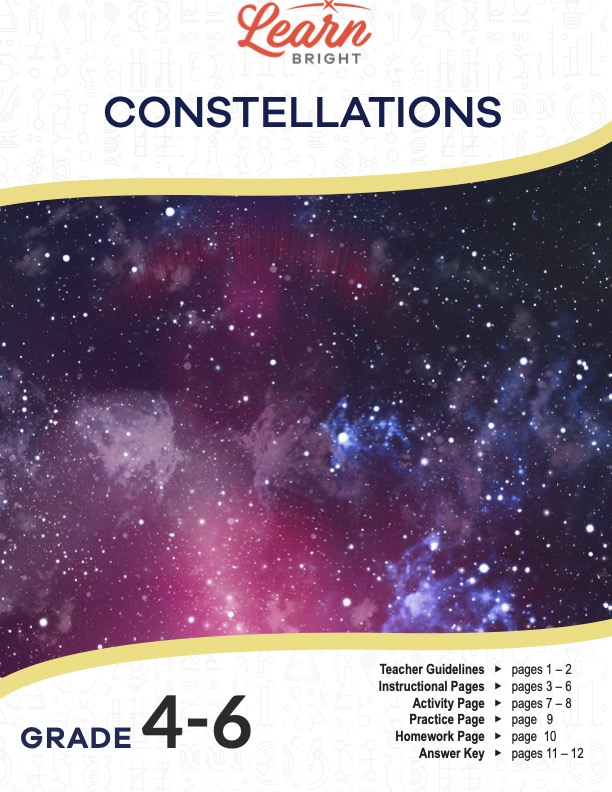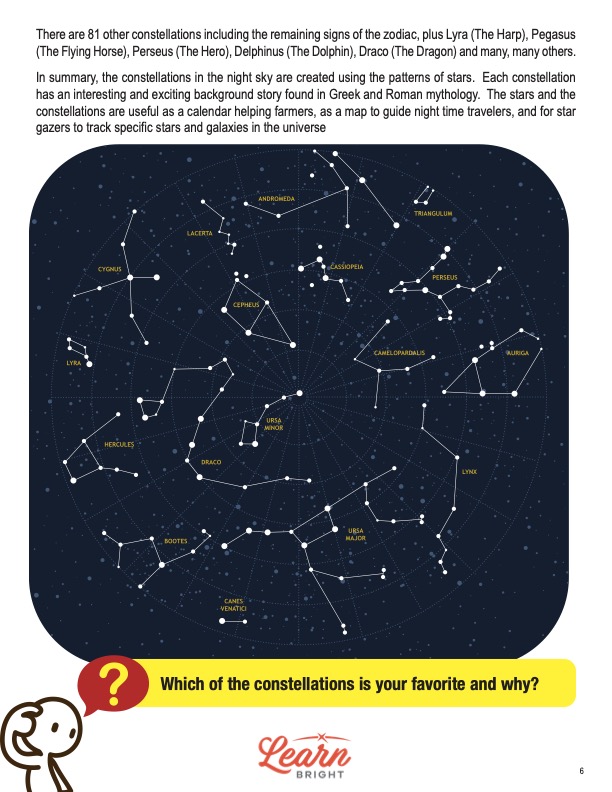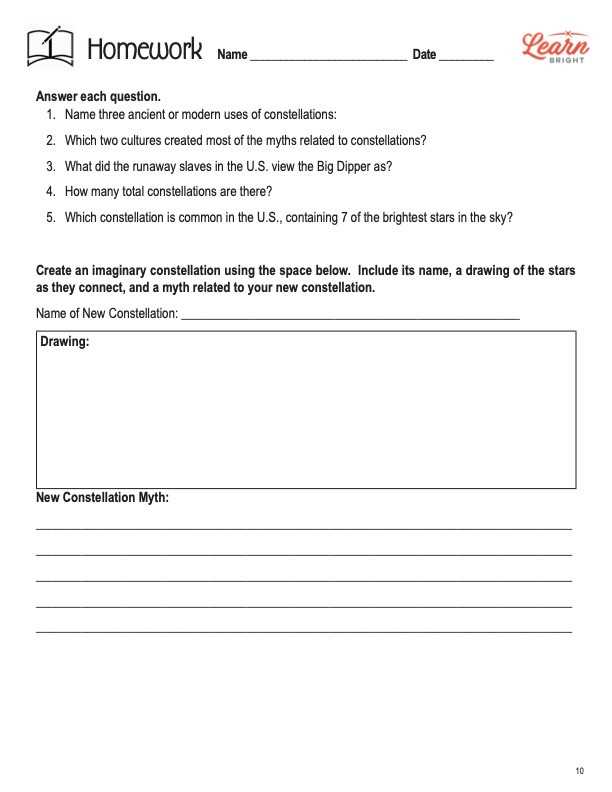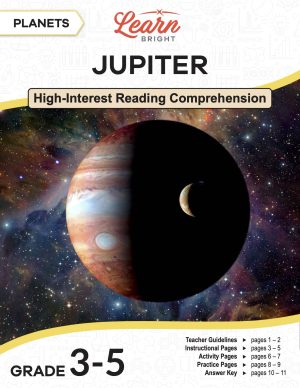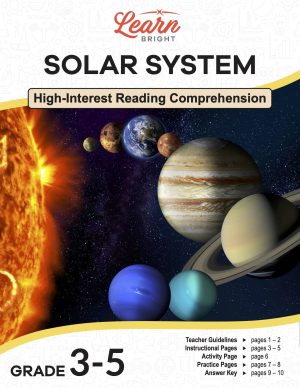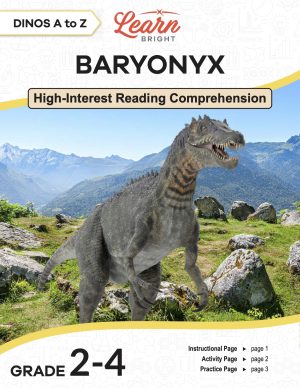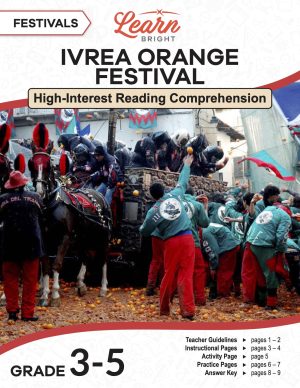Description
What our Constellations lesson plan includes
Lesson Objectives and Overview: Constellations explores the history and uses, both ancient and modern, of these special star patterns in the sky. Students will discover facts about some famous constellations and be able to describe the myths behind them. This lesson is for students in 4th grade, 5th grade, and 6th grade.
Classroom Procedure
Every lesson plan provides you with a classroom procedure page that outlines a step-by-step guide to follow. You do not have to follow the guide exactly. The guide helps you organize the lesson and details when to hand out worksheets. It also lists information in the yellow box that you might find useful. You will find the lesson objectives, state standards, and number of class sessions the lesson should take to complete in this area. In addition, it describes the supplies you will need as well as what and how you need to prepare beforehand.
Options for Lesson
There are a number of suggestions in the “Options for Lesson” section that you can consider including with the lesson plan. A few options relate specifically to the activity worksheet. One suggestion is to allow students to work in pairs or groups for the activity or to have students research only one constellation. Another is to use construction paper instead of the worksheet so that students have more room to work with for their presentations. Another option is to create a constellation book. You could also have students meet during after school hours if possible to view a clear night sky and try to identify various patterns. One last option is to invite an astronomer to speak with the class.
Teacher Notes
The paragraph on this page gives you a little more information or guidance on the lesson plan. It suggests possibly visiting a planetarium to provide even more information on the various constellations. It also mentions teaching the lesson in conjunction with another on astronomy or mythology. Use the blank lines on this page to write down any other thoughts or ideas you have prior to giving the lesson.
CONSTELLATIONS LESSON PLAN CONTENT PAGES
Twinkle, Twinkle Little Star
The Constellations lesson plan has four pages of content. The first page provides a little background information on the Milky Way galaxy and stars in general. The Milky Way is home to earth’s solar system, but it also contains over 300 billion stars. Astronomers believe the number of galaxies in the universe exceeds 100 billion. That means there are trillions of stars throughout the universe, about 70 billion trillion, which is 7 with 22 zeros!
Students will discover that not every star is visible, especially with the naked eye. What people can see on a clear night is around 4,500 stars. Some of them have their own systems of planets, and some are very old. Then there are some that no longer exist, but remain visible because the light is still traveling toward earth.
The brightest stars form special patterns in the sky. These patterns form shapes of people, animals, and mythological beings. Early astronomers called these patterns constellations. Each star in the pattern connects to form a different constellation. The ancient Greeks and Romans created stories around these different patterns of stars. We call these stories myths.
Myths and Uses
Generally speaking, constellation myths relate to gods, heroes, and creatures like serpents and bears. In 1922, the sky was divided into 88 total patterns. For the most part, these patterns appear to be a series of straight lines. People used their imaginations to create the images that these simple lines would represent.
Other cultures have created their own myths that relate to the constellations. Some were religious in nature, some helped people explain daily events, and others related to a specific hero. For instance, a hero was given a special place of honor in the sky as a tribute or reward for his heroism.
There are both ancient and modern uses for the constellations. These patterns helped ancient farmers know when to plant and harvest their crops. They were essentially a calendar in the sky. Travelers also use them to navigate from one place to another, relying on different stars to guide their journeys throughout the world. Today, modern astronomers and star gazers use them to keep track of specific stars. They also use them to locate other objects, such as galaxies or nebulae, which are areas clustered with gas and dust.
Every constellation has a name, and some have more than one name depending on the culture. The Big Dipper, for instance, is known as a plough in Great Britain and a saucepan in France. The Mayans referred to it as Seven Macaw, and the Hindus saw seven wise men. Runaway slaves in the U.S. considered the Big Dipper a symbol of freedom because they followed it on their journey to the North.
Famous Constellations
Students will then learn about specific star patterns. There are 88 total constellations in the night sky. Not all of them are famous or as popular or well used as others. Many are visible in the Northern Hemisphere but not in the Southern Hemisphere, and vice versa. Some are only visible during certain times of the year.
The lesson provides facts about seven specific constellations: Andromeda, Cancer, Cygnus, Hercules, Orion, Taurus, and Ursa Major. Andromeda is the furthest object can people can see with the naked eye. The Greeks named this constellation after mythical Princess Andromeda, famous for her beauty, who married Perseus. The image is of a woman hurling across the night sky.
Cancer is one of the dimmest star patterns. It is one of the signs of the zodiac. In fact, every zodiac sign is a constellation. The word means “crab” in Latin. Cygnus often goes by another name, Northern Cross. Its Latin name stands for swan, hence the constellation’s image. It is also the brightest overall constellation in the sky. Hercules is one of the largest constellations, but the stars that make up the pattern are dim. Several planets are visible within the pattern.
Orion mainly consists of bright blue supergiant stars. Three stars form what we call Orion’s Belt, which lead to Sirius, the brightest star in the sky. Orion was a giant hunter in Greek mythology who defended himself from Taurus. Taurus is a large pattern as well that people may have first identified over 10,000 years ago. It looks like the image of a bull, hence its Latin name which means bull. Ursa Major is Latin for “great bear” and relates to Ursa Minor, or little bear. Other constellations include Pegasus, Draco, and Delphinus.
Key Terms
Here is a list of the vocabulary words students will learn in this lesson plan:
- Constellation: a special pattern of stars that connects to form a picture
- Myth: an ancient story, usually about gods, heroes, and creatures like dragons and flying horses
- Nebulae: the areas in the universe where gas and dust are cluttered
CONSTELLATIONS LESSON PLAN WORKSHEETS
The Constellations lesson plan includes three worksheets. Each of these worksheets help students better grasp the material and concepts they learned throughout the lesson. You can refer to the guide on the classroom procedure page, which outlines when to hand out the worksheets to your students.
CONSTELLATIONS ACTIVITY WORKSHEET
For the activity, you will assign students two constellations to research either online or using other resources. Students will discover various facts and complete a number of prompts for each one. They will need to name a few of the stars within the pattern, write the best months of the year to see it, and list two facts that are not related to mythology. They will then summarize the myth behind it, draw the pattern connecting the stars, and finally do their best to draw the image that matches the myth.
FILL IN THE BLANK PRACTICE WORKSHEET
The practice worksheet is split into two sections. The first section requires students to fill in the blanks in 14 sentences. Students will use the terms in the word bank at the top of the page. For the second section, students will match the names of seven constellations to the correct image. The worksheet does not actually have pictures for this section. Instead, it simply names what the images look like. For example, they list things like “swan” and “crab.”
A NEW CONSTELLATION HOMEWORK ASSIGNMENT
There are two parts of the homework assignment as well. The first part requires students to answer five questions about the lesson material. The second part involves creating a whole new constellation. Students will draw a picture in the empty box on the worksheet and come up with a name and a mythical story. They will use the lines at the bottom of the page to write out the myth.
Worksheet Answer Keys
The last couple pages of the lesson plan are answer keys for the practice and homework worksheets. The answers are in red for both handouts. The second part of the homework assignment does not have answers since it does not test students’ knowledge of the material. You can determine whether or not the students receives credit for this part of the assignment using your own judgment. If you choose to administer the lesson pages to your students via PDF, you will need to save a new file that omits these pages. Otherwise, you can simply print out the applicable pages and keep these as reference for yourself when grading assignments.

